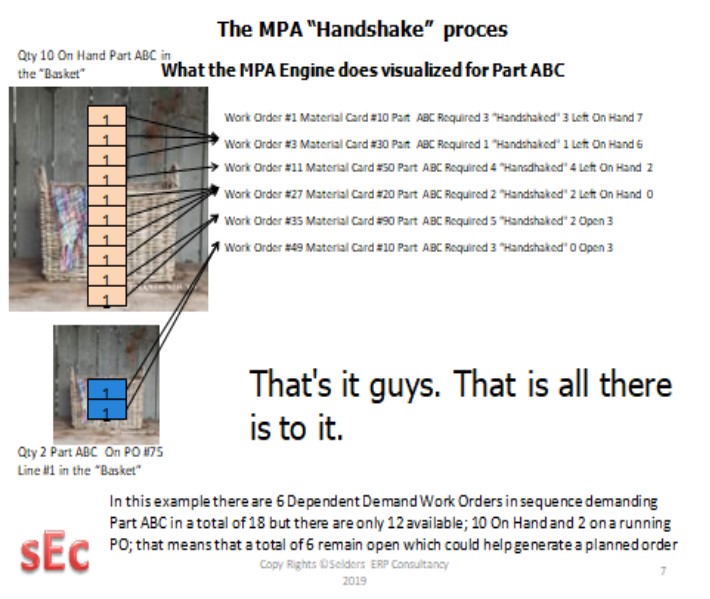What is that concept and how does it work?
The concept of the pilot program is actually very simple. As already mentioned, all current sales orders and finished product and semi-finished product work orders are listed in order of requirement date. The order that should be delivered first, according to its requirement or demand date, is also the first to make a claim on the required item number and quantity. This claim with the requested quantity can be done on the free stock, current semi-finished work orders or Purchase Orders, which are going to deliver the requested item.
In the first instance, it is always checked how much of this item number is in stock, or still in stock. In the list of orders placed in sequence by demand date, there are almost always several orders that require the same material. But the first order to act may also be the first to claim the available stock.

An example:
Suppose there are 10 pieces in stock of item A and the first order in the line, Order #1, needs 4. The program then records in the sales order line, in addition to the quantity required, the quantity that may be taken from that stock. There are then 6 left for succeeding orders.
With that stock item A, it is recorded that 4 pieces of the 10 could be allocated to order #1. Now order # 2 is next and it asks for a different article number; but the same thing happens. Now order #3 is next and it appears to have a need for item A; 8 pieces to be precise. But there are only 6 left that could be allocated from the free stock.
In the sales order line of order #3, next to the required quantity 8, the 6 pieces fulfillment from the free stock is recorded and it is additionally recorded that these 6 are coming from free stock. However, 2 more pieces have to be found for order #3. The program will then search for a work order that is already in the system and from which item A will be produced. Should such an article be able to be purchased, as well as manufactured, manufacturing it is generally faster and cheaper, therefore the program first searches for a work order.
Suppose there is not (yet) a single work order for the item, perhaps simply because item A has never been manufactured but always purchased. The program will then continue to search if there is already a Purchase Order with one or more Purchase Order lines with which item A can be purchased.
Suppose there is a Purchase Order #20 with that item number that has not yet been delivered, with quantity 10. Two of these are ‘claimed’ for order #3 and 8 pieces are still open for subsequent sales or work orders that will have a need for item A in the course of the program. In the sales order line of order #3, in addition to the 6 pieces that were already committed from free stock, the 2 pieces are also recorded, and that they come from Purchase Order #20. So, the Purchase Order ID is also recorded there. In the Purchase Order line of Purchase Order #20, in addition to the quantity 10, the quantity 2 is recorded and also to which sales order and sales order line those 2 could be assigned. So, the order ID and order Line ID of order #3 are recorded in the order line of Purchase Order #20.
If there is no Purchase Order at all for item A, item A is eligible to have a Planned order created, in which case it is noted that the requirement (in this example, the remaining quantity of 2 pieces) comes from order #3.
And so, the program continues until all sales orders and work orders that require items, materials and components have been completed.
After this run, all orders now have the detailed data of the free stock coverage and/or the coverage from semi-finished product work orders and Purchase Orders. It is then known over the entire set of orders how the free stock and work orders and Purchase Orders are used to provide coverage. And in the stock records and order records of the work orders and Purchase Orders that provide that cover, specific details of intended cover are provided.
That stock, and those semi-finished product work orders and Purchase Orders that do not contain this detailed information, are then clearly not requested by any sales order or end product work order. And where Planned orders have arisen, there is apparently a shortage that must be supplemented in the foreseeable future in order not to stagnate production. But because all this data has been recorded in detail, material planners and buyers can also work in a very targeted manner utilizing real, and realistic, exception reporting.